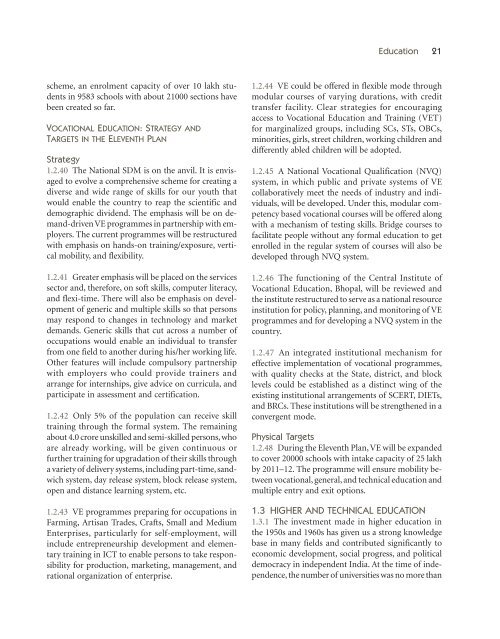Eleventh Five Year Plan
Eleventh Five Year Plan
Eleventh Five Year Plan
Create successful ePaper yourself
Turn your PDF publications into a flip-book with our unique Google optimized e-Paper software.
Education 21scheme, an enrolment capacity of over 10 lakh studentsin 9583 schools with about 21000 sections havebeen created so far.VOCATIONAL EDUCATION: STRATEGY ANDTARGETS IN THE ELEVENTH PLANStrategy1.2.40 The National SDM is on the anvil. It is envisagedto evolve a comprehensive scheme for creating adiverse and wide range of skills for our youth thatwould enable the country to reap the scientific anddemographic dividend. The emphasis will be on demand-drivenVE programmes in partnership with employers.The current programmes will be restructuredwith emphasis on hands-on training/exposure, verticalmobility, and flexibility.1.2.41 Greater emphasis will be placed on the servicessector and, therefore, on soft skills, computer literacy,and flexi-time. There will also be emphasis on developmentof generic and multiple skills so that personsmay respond to changes in technology and marketdemands. Generic skills that cut across a number ofoccupations would enable an individual to transferfrom one field to another during his/her working life.Other features will include compulsory partnershipwith employers who could provide trainers andarrange for internships, give advice on curricula, andparticipate in assessment and certification.1.2.42 Only 5% of the population can receive skilltraining through the formal system. The remainingabout 4.0 crore unskilled and semi-skilled persons, whoare already working, will be given continuous orfurther training for upgradation of their skills througha variety of delivery systems, including part-time, sandwichsystem, day release system, block release system,open and distance learning system, etc.1.2.43 VE programmes preparing for occupations inFarming, Artisan Trades, Crafts, Small and MediumEnterprises, particularly for self-employment, willinclude entrepreneurship development and elementarytraining in ICT to enable persons to take responsibilityfor production, marketing, management, andrational organization of enterprise.1.2.44 VE could be offered in flexible mode throughmodular courses of varying durations, with credittransfer facility. Clear strategies for encouragingaccess to Vocational Education and Training (VET)for marginalized groups, including SCs, STs, OBCs,minorities, girls, street children, working children anddifferently abled children will be adopted.1.2.45 A National Vocational Qualification (NVQ)system, in which public and private systems of VEcollaboratively meet the needs of industry and individuals,will be developed. Under this, modular competencybased vocational courses will be offered alongwith a mechanism of testing skills. Bridge courses tofacilitate people without any formal education to getenrolled in the regular system of courses will also bedeveloped through NVQ system.1.2.46 The functioning of the Central Institute ofVocational Education, Bhopal, will be reviewed andthe institute restructured to serve as a national resourceinstitution for policy, planning, and monitoring of VEprogrammes and for developing a NVQ system in thecountry.1.2.47 An integrated institutional mechanism foreffective implementation of vocational programmes,with quality checks at the State, district, and blocklevels could be established as a distinct wing of theexisting institutional arrangements of SCERT, DIETs,and BRCs. These institutions will be strengthened in aconvergent mode.Physical Targets1.2.48 During the <strong>Eleventh</strong> <strong>Plan</strong>, VE will be expandedto cover 20000 schools with intake capacity of 25 lakhby 2011–12. The programme will ensure mobility betweenvocational, general, and technical education andmultiple entry and exit options.1.3 HIGHER AND TECHNICAL EDUCATION1.3.1 The investment made in higher education inthe 1950s and 1960s has given us a strong knowledgebase in many fields and contributed significantly toeconomic development, social progress, and politicaldemocracy in independent India. At the time of independence,the number of universities was no more than












![[Tam] Uygula[ya] - Bilim, Teknoloji ve Ä°novasyon Politikaları TartıÅma ...](https://img.yumpu.com/36820041/1/184x260/tam-uygulaya-bilim-teknoloji-ve-anovasyon-politikalara-tartaama-.jpg?quality=85)



